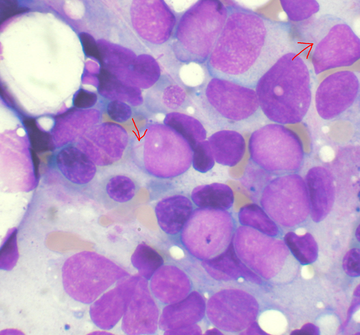Ho sabíeu?
Podeu fer doble clic en una paraula per a buscar-la a TermGallery.
Podeu fer doble clic en una paraula per a buscar-la a TermGallery.
Significats de anll en anglès

Myeloid leukemia that is characterized by the rapid growth of abnormal white blood cells that accumulate in the bone marrow and interfere with the production of normal blood cells.
Veure'n mésÚs de anll en anglès
1
Complete remission was induced in about 80% of ANLL patients in both chemotherapies.
2
These findings underscore the heterogeneity of ANLL.
3
When the growth fraction was considered, however, ANLL proliferative activity was higher and more like that of normal BM.
4
HL-60 cells and ANLL cells were incubated with or without retinoids for 5 days.
5
As previously reported for ALL in infants, ANLL of infancy shows a similar heterogeneity regarding phenotypic and genotypic features.
6
At diagnosis of ANLL, all of the patients had a panmyelosis with variation in the predominant abnormal cell line.
7
The ANLL was commonly heralded by a brief preleukemic phase consisting of cytopenias and a variety of morphologic abnormalities.
8
We report on a patient with M4 - ANLL presenting with acute abdomen without any evidence of blood disorder.
9
Intensive therapy is indicated in the elderly patient 61 to 70 years of age with ANLL.
10
In contrast, evidence for B cell involvement was not detected in the patient whose ANLL progenitor cells exhibited restricted differentiative expression.
11
There were similar statistical significance for ANLL and ALL patients, P = 0.0271 and P = 0.0266 respectively.
12
Twenty-seven patients over 60 years of age with acute nonlymphocytic leukemia (ANLL) were prospectively treated with one of three intensive chemotherapeutic regimens.
13
Our study confirms the high incidence of myelomonocytic and monoblastic subtypes in infants with ANLL, which are particularly closely associated with chromosome 11 abnormalities.
14
These data show that MDR is very frequent in ANLL also at diagnosis and suggest that MDR can contribute to early failure of standard treatment.
15
Bacterial or fungal infections (considered life-threatening or fatal) occurred in 17 children with ALL and in 7 with ANLL.
Col·locacions frequents
Translations for anll
portuguès
espanyol
Anll a través del temps

